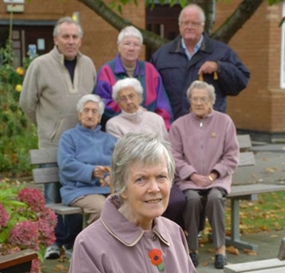Grandma Moses can be a role model for ‘seniors’. Died when she was 101, had 10 children and did hard farm work from the age of 12. She was unfailingly positive in her attitude and thought like my own mother who always said, “Hard work never killed anybody.”
As Grandma Moses got older and found the physical demands of farm work too onerous, she took up embroidery to fill up her spare time. At the age of seventy-six she gave up embroidery and began to paint, because of arthritis in her hands making needlepoint too difficult. At an age where many people are ready to give up, this remarkable woman started a new ‘career’, and a very successful career that was, with many of her paintings hanging in art galleries throughout the world.

I draw the comparison between Grandma Moses and ‘senior’ photographers, because photography is a pursuit, and an art form, that can be very satisfying, and yet be within the physical capabilities of people when they get older.
Modern cameras have all but removed all obstacles in the way of anyone’s ability to take pictures – from small children through to today’s Grandma Moses!
So what should a senior photographer look for with today’s cameras? The first thing to look for is light weight. As you get older, the ability to manipulate heavy cameras goes, and some of the really good cameras are far too heavy. Look for a point and shoot camera, or a ‘bridge’ camera that is light enough for you to handle. Forget the Nikon F3 or a Canon EOS, both excellent cameras, but with weights of over one kg without a lens attached, these are far too heavy.
Before I forget (another ‘senior’ moment), another very important accessory for seniors doing photography is your reading glasses! To be able to check your shots, the camera settings and the battery life left you will need your readers! Hang them on a string around your neck! You will thank me.
As our eyesight starts to fall off, the average senior soon thinks that photography is beyond them, as it is too difficult to get the subject in sharp focus. Modern technology has come to your rescue. Almost every new camera has “Auto-Focus”, usually called AF. Looking at the subject and depressing the shutter button half way, the camera will look for you and focus for you and even let you know that focus has been reached, usually with a ‘beep’ and a green light. Sure, there are some tricks to be learned as to how to get the AF work for you in all situations, but it isn’t too difficult. Beep and green light technology.
To make it possible to get even better and sharper photos, the camera designers had you seniors in mind. So your hands aren’t rock steady any more, don’t worry, there is a thing called “anti-shake” technology in today’s cameras. The camera itself will settle all but the biggest tremors that being a senior will bring. This feature is not something in every camera, but if you ask at the camera store, they will tell you which models have it. They have fancy names like Optical Image Stabilization, but “anti shake” will do.
The next important feature in a camera for seniors is the ‘zoom’ capability. Even the better compacts have built in zooming. I would never expect an 80 year old to clamber over rocks to get a photo of a turtle digging a hole in the sand, but with a half decent zoom, that shot is possible from this side of the rocks, even from a wheelchair. The famous photographer Ansel Adams once said, “A good photograph is knowing where to stand.” With a zoom lens that is easy.
The thoughts of ‘exposure’ settings and such can be daunting for seniors, but every camera today has its “P” setting. A ‘program’ that works out the optimal exposure, both shutter speed and aperture. You don’t even need to know what those words mean – the camera will do it all. The senior photographer just has to work out what he or she wants to photograph and then its composition.
Photography is for all ages, especially seniors!




